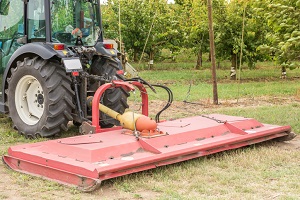There is a lot of debate over whether or not slashing benefits pastures. Slashing is not a common practice on larger properties but it is often done on smaller properties, in many cases for reasons other than for improving the pasture.
Before slashing ask:
• Why are we doing it?
• Will it provide better grazing for stock?
• How much will it cost?

Some reasons for slashing include:
• Increasing mulch on the soil. The slashed grass needs to be in direct contact with the soil to add organic matter. Often the slashed material sits on top of the grass and acts as a mulch, slowing pasture recovery and not contributing to the soil organic matter. Is this better than burning? It depends on the pasture but a good fire can stimulate native pastures while a very hot fire can destroy pastures. The choice between slashing and burning will depend on the situation.
• Reducing the bulk of pasture. A large bulk of pasture can be a fire hazard but it can also be a valuable source of standover feed for the coming winter when it can be fed with a protein supplement. The value of the pasture as potential feed will have to be balanced against the potential fire hazard, taking into consideration the seasonal conditions.
• Promoting new pasture growth. If pastures are not grazed they can become rank and unpalatable. Slashing can promote new and more palatable pasture growth, but it is often better to vary stocking rates to reduce rank growth if possible. Studies researching the impact of slashing on productivity have had conflicting results, and vary with pasture species. Generally though, the cost of slashing outweighs the gains achieved in new pasture growth. Better grazing management is often the easier alternative.
• Managing annual weeds. Slashing can be a great tool in controlling weeds, such as thistles, that can establish on bare ground during variable weather conditions and compete with pastures. These weeds need to be slashed before they go to seed, otherwise the slasher will spread the weed seeds further afield and compound the problem.
• Managing woody weeds. Plants such as wild rosemary (Cassinia laevis) and some wattles can be controlled by slashing when they are small, reducing the likelihood of having to undertake a major weed control program after the weeds become established. Several follow-up treatments will often be necessary to control the plants that re-sprout after the initial slashing.
• Establishing new pastures. New pastures can become dominated by annual weeds that take advantage of the disturbed soil. Slashing before these weeds flower will reduce moisture stress and competition for the new pasture. The new pasture may have to be spelled longer, however, to let it go to seed.
• Evening out variations in grazing. A paddock with a set-stocking rate will generally have grazed and ungrazed patches. Slashing will help to even up the pasture but a better option is to use a rotational grazing system to even out the grazing pressure on the pasture. In rotational grazing, stock are moved as a group through two or more paddocks on a regular basis. This improves the management of the grazing pressure and gives pastures in the ungrazed paddocks an opportunity to recover.
• Making it look tidy. Many landowners who slash are really cutting the grass just to make it look tidy. They justify slashing by saying it puts mulch back into the soil. However, if the grass was left standing it would provide more habitat and protection for a variety of fauna that ultimately carry out the mulching as a natural process. A short pasture may look tidy, but it makes the soil more susceptible to evaporation and runoff than under natural pasture.
• Controlling blady grass. This grass is unpalatable so it is often slashed to allow other, more palatable, grasses to grow. For effective management of blady grass in pasture, the patches need to be slashed for a number of years as well as being fertilised and seeded with legumes.
Other tips for slashing and pasture management:
• Slashing by itself will not change long-term pasture composition. Burning native pastures, if managed carefully at the correct time of the year, will be more effective in favouring the germination and establishment of desirable pasture species. Grazing management can also change pasture composition.
• A bulky, low quality pasture can be slashed and baled, with the bales being used to rehabilitate bare or eroded areas on the property.
• Regularly sharpening the slasher blades will dramatically reduce the fuel used and time taken to cut an area. This is particularly apparent when slashing weedy grasses such as African lovegrass or giant rats tail grass.
• After slashing, always use a broom or compressed air to clean off the slasher deck so that weed seeds are not carried into clean areas. Preferably slash before weeds go to seed.
Slashing can be a valuable tool in pasture management in some situations, but use it for a good reason. In most situations, using stock to do the job will be far cheaper and less time consuming than slashing. Smaller paddocks marked out by electric fences provide better pasture management options than slashing.
Acknowledgement: This article is courtesy of the Beeftalk Magazine.
News Category



